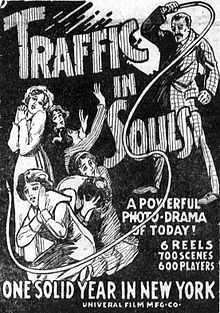Traffic in Souls


Traffic in Souls is a 1913 narrative feature film focusing on forced prostitution (white slavery) in the US. The film was produced by Universal Studios in Fort Lee, New Jersey, where many early film studios in America's first motion picture industry were based at the beginning of the 20th century.[1][2][3]and filmed there, on location on Ellis Island and Manhattan. Its subjects were working women and immigrants to the US and it was released at a time when the country was undergoing a "moral panic" over the issue of prostitution.[4] The film's release eventually resulted in the adding of "white slavery" to the list of topics banned under the Hays Code.[5][6]
In 2006, the film was added to the National Film Registry for preservation in the Library of Congress because it "presaged the Hollywood narrative film" and drew attention through its riveting depiction of the methods used to entrap young women into prostitution.[7]
It was an early example of the narrative style in American films. It was six reels, long for an American film at the time.[5]
The storyline concerns two young Swedish women immigrants who are approached by men soliciting for white slavery under the guise of a legitimate work offer. In the scenes filmed at the Battery, after the women are transported there from Ellis island, real life immigrants can be seen in the background.[8] The entire film takes place in three days and consists of a prologue, the main narrative in which one of the sisters is kidnapped by a pimp and the other sister and her boyfriend rush to rescue her in time and the pimp is killed, and an epilogue in which the viewer finds out the consequences from a trashed news article. It concludes with a joke ending, an ending to a thriller that at the time was not the cliché it has become now.[9]
See also
- George Loane Tucker - director
- Walter Long - actor
Notes
- ↑ Koszarski, Richard (2004). Fort Lee: The Film Town. Indiana University Press. ISBN 0-86196-652-X.
- ↑ "Studios and Films". Fort Lee Film Commission. Retrieved 2011-05-30.
- ↑ Fort Lee: Birthplace of the Motion Picture Industry. Arcadia Publishing. 2006. ISBN 978-0-7385-4501-1.
- ↑ Olund, Eric (October 2007). "Traffic in Souls: the ‘new woman,’ whiteness and mobile self-possession". Cultural Geographies 16 (4). doi:10.1177/1474474009340088. Retrieved November 27, 2011.
- ↑ 5.0 5.1 Brewster, Ben (Autumn 1991). "'Traffic in Souls': An Experiment in Feature-Length Narrative Construction". Cinema Journal 31 (1): 37–56. Retrieved November 27, 2011.
- ↑ Matsubara, Hiroyuki (2006). "The 1910s Anti-Prostitution Movement and the Transformation of American Political Culture". The Japanese Journal of American Studies (17): 56.
- ↑ "Films Added to National Film Registry for 2006" (Press release). Library of Congress. December 27, 2006. Retrieved November 27, 2011.
- ↑ Grieveson, Lee. "Policing the cinema: Traffic in Souls at Ellis Island, 1913". Oxford Journals 38 (2): 149–171. Retrieved November 27, 2011.
- ↑ Grieveson, Lee; Krèamer, Peter (2004). The silent cinema reader. New York: Routlege. pp. 226–237. ISBN 0-415-25284-9.